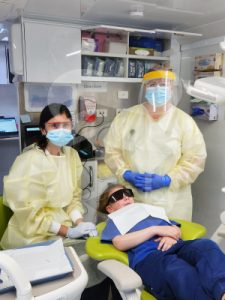Rural kids all smiles as mobile dental van comes to school
Kids in regional and remote Northern NSW communities will have a faster and more convenient trip to the dentist, thanks to a new mobile dental van operating in the region.
Minister for Regional Health Ryan Park said the dental van is expected to provide preventive dental care and treatment for hundreds of school children this year.
“The schools involved in this program are in regional and remote communities, so by bringing this service to them we’re removing the barriers to accessing dental services,” Mr Park said.
“We know dental healthcare is critical to children’s physical development and wellbeing, and we know regular dental check-ups are linked to better outcomes in childhood.”

District Team Leader Senior Oral Health Therapist Naiha Ahmad, student Hallie and District Team Leader Dental Assis
The service is an extension of the NSW Health Primary School Mobile Dental Program, and Northern NSW Local Health District Oral Health Service is running a pilot program to visit several local primary schools throughout 2023.
Dr Angie Nilsson, Clinical Director Oral Health Services, said primary school children are at an important point in their dental journey as their adult teeth start to come through.
“We’re helping kids set good oral health practices for life and ensuring they get the best start for healthy teeth and gums,” Dr Nilsson said.
“It can take more than two hours for some of our communities to travel to access the public dental service, and in areas with limited public transport options, it’s even more of a challenge.”
The services will include check-ups, cleans, x-rays and other preventive treatments and will help to set children on a path to good dental health for life.
Member for Lismore Janelle Saffin said she was pleased this essential service would visit four primary schools across Northern NSW.
“Some regional and remote communities in our region experience significant barriers to dental care, so this is a really wonderful initiative to bring preventive healthcare to some of our youngest residents,” Ms Saffin said.
“Children in Bonalbo have already benefited from the service, and it is great to know the mobile clinic is planned to visit students in Urbenville, Tabulam and Kyogle.”
Bonalbo Central School was the first school to host the dental van in May, with close to 100 percent of the primary school children receiving check-ups.
Bonalbo Central School Relieving Assistant Principal, Kim James, said the program had been extremely well received.
“Students from kindergarten to Year 6 had dental check-ups and minor dental work done, which was fantastic,” Mrs James said.
For Year 1 student, Hallie, it was her first experience at the dentist and she loved it.
Hallie’s mum, Kara, said the program was a huge time saver for her family.
“As a full-time working parent living remotely it is harder to be able to make appointments for treatment which is over an hour away,” Kara said.
For more health news, click here.





 Tweed Shire News2 years ago
Tweed Shire News2 years ago
 Motoring News1 year ago
Motoring News1 year ago
 COVID-19 Northern Rivers News3 years ago
COVID-19 Northern Rivers News3 years ago
 COVID-19 Northern Rivers News3 years ago
COVID-19 Northern Rivers News3 years ago
 Northern Rivers Local News3 years ago
Northern Rivers Local News3 years ago
 Health News3 years ago
Health News3 years ago
 COVID-19 Northern Rivers News3 years ago
COVID-19 Northern Rivers News3 years ago
 NSW Breaking News3 years ago
NSW Breaking News3 years ago























